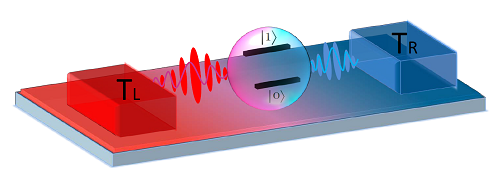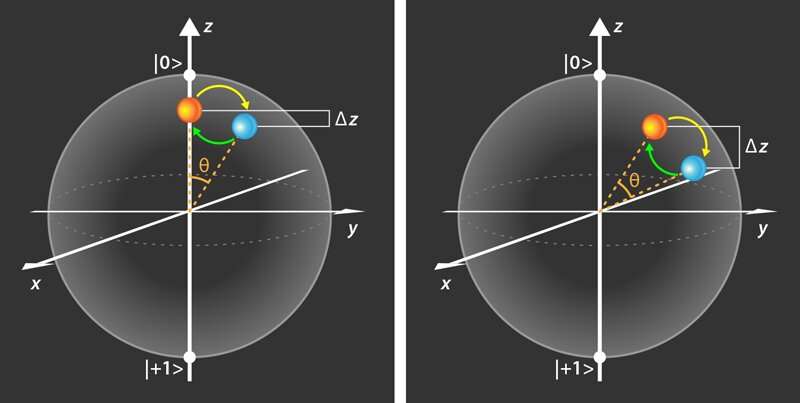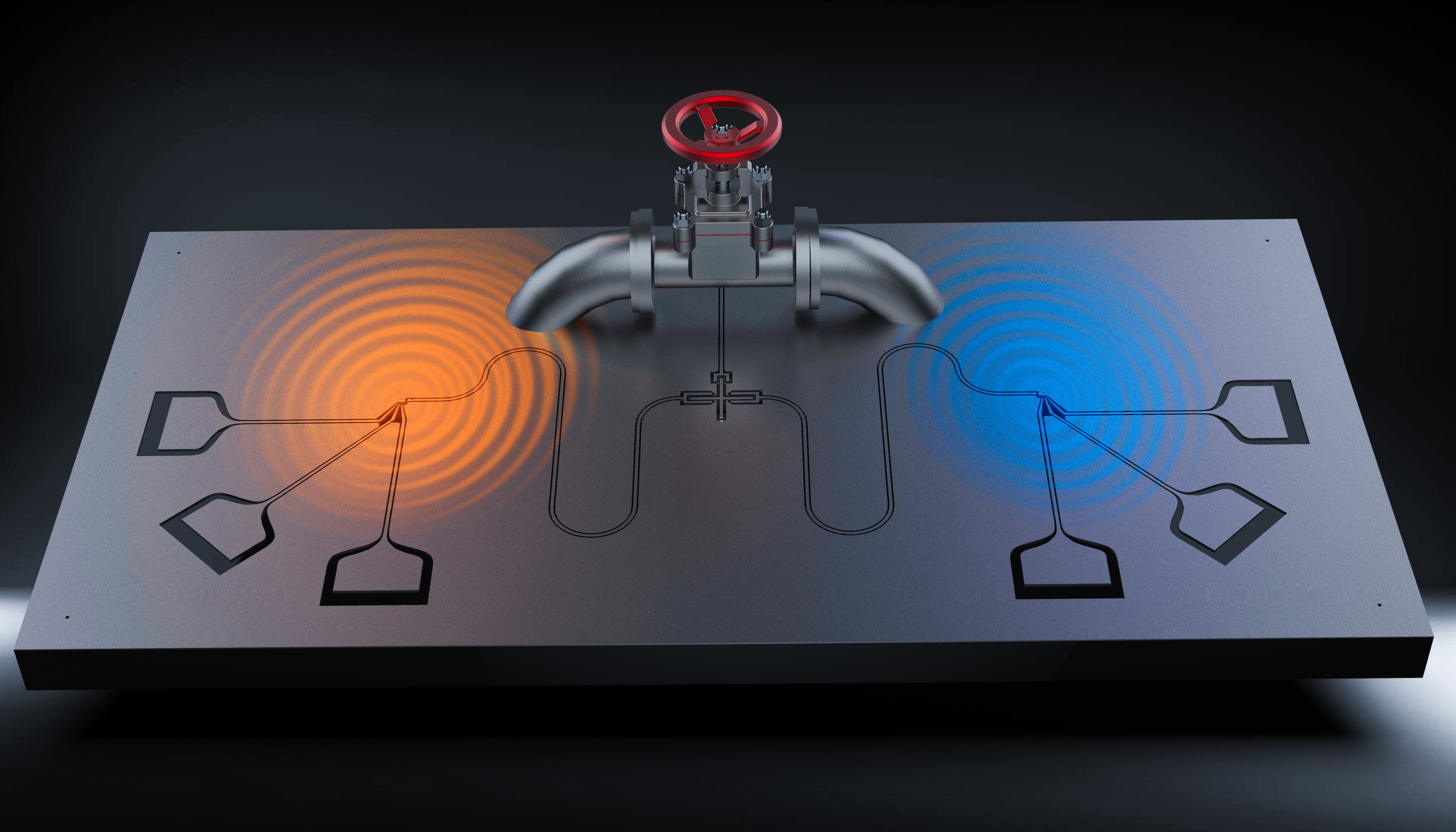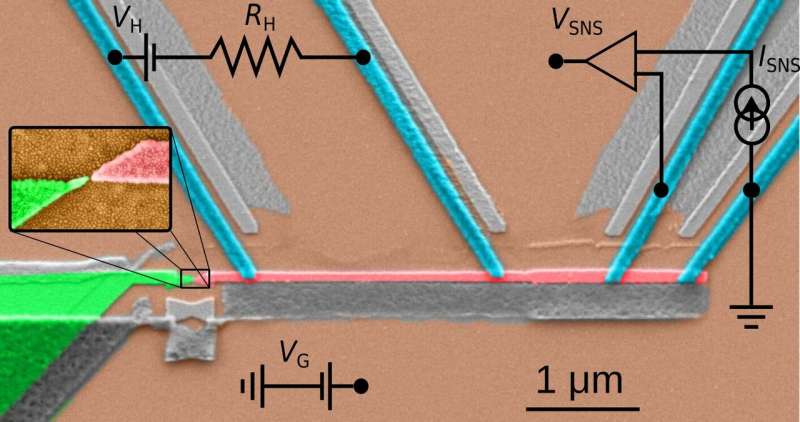One of the most important features of thermodynamics is that it has improved human quality of life amazingly during the last centuries. Since in 1606, the Spanish inventor Jerónimo de Ayanz y Beaumont patented the first steam engine a great effort has been done in developing new and better thermal machines. Internal combustion engines, heat pumps and refrigerators are some of the principal heat machines used nowadays.
Certainly, the main theoretical milestone for the developing of thermal machines was performed by the French military engineer Sadi Carnot, by deriving the cycle of maximum efficiency. This reversible cycle is also known as the Carnot’s Cycle and the ideal machine that performs it is called Carnot’s Engine. This ideal engine works between two thermal baths with different temperatures (TC for the cold bath, and TH for the hot one), and its efficiency is given by a simple relation. This efficiency is the maximum allowed by classical thermodynamics, and all thermal machines are limited by it.
However, the thermodynamics is a macroscopic theory, and its applications to microscopic systems is still not clear. A quantum heat engine is a device that generates power from the heat flow between hot and cold reservoirs. The operation mechanism of the engine can be described by the laws of quantum mechanics. The theoretical notion of a ‘quantum heat engine’ has been around for several decades. It was first introduced around sixty years ago by Scovil and Schulz-DuBois, two physicists at Bell Labs who drew an analogy between three-level masers and thermal machines.
Quantum refrigerators share the structure of quantum heat engines with the purpose of pumping heat from a cold to a hot bath consuming power first suggested by Geusic, Schulz-DuBois, De Grasse and Scovil. When the power is supplied by a laser the process is termed optical pumping or laser cooling, suggested by Weinland and Hench. Surprisingly heat engines and refrigerators can operate up to the scale of a single particle thus justifying the need for a quantum theory termed quantum thermodynamics.

Physicists have studied quantum heat engines for many years—they work in ways similar to classical heat engines, but their “working fluid,” which behaves in ways reminiscent of steam in a steam engine, can be in a coherent superposition. This has led many in the field to wonder if quantum engines could actually perform better than the classical engines we see around us every day. Just four years ago, a team at Hebrew University of Jerusalem claimed to have found the answer, reporting a theory that suggested that quantum engines could, indeed, be more efficient than classical engines. In this new effort, the researchers have conducted experiments showing that the theory was correct.
In the years that followed, other researchers have developed a variety of theories building on the ideas of Scovil and Schulz-DuBois, introducing proposals of thermodynamic cycles at the quantum scale. Very recently, physicists have started testing some of these theories in experimental settings.
One main result of this analysis is that the microscopic heat machines, and only them, can approach the maximum efficiency of Carnot’s cycle. Also, the efficiency of such machines is universal, depending only in the temperatures of the baths and not in details as the coupling between the qubits and the baths. This result is very different of what we find in macroscopic thermal machines, where the efficiency depends on many parameters and it is always below Carnot’s efficiency. Skrzypczyk et al argue that this different behavior from microscopic to macroscopic machines is due to the fact that many microscopic machines compose a macroscopic one. It is the way of composing them what breaks the universality of the efficiency and what reduces it from the maximum one.
Only recently, the possibility of creating a microscopic refrigerator, based on quantum mechanics’ rules, has been developed. Physicist from United Kingdom discuss the problem of finding the set of smallest heat machines, and the thermodynamic properties of such set. In these works it is probed that a very simple model of heat machine can be performed just by the use of three two levels systems, or qubits (for quantum bits).
The experimental demonstration of a spin quantum heat engine reported in Dec 2019
One of these experiments was carried out by a team of researchers at the University of Waterloo, Universidade Federal do ABC and Centro Brasileiro de Pesquisas Físicas, who successfully demonstrated a spin quantum heat engine in a laboratory setting. Their paper, published in Physics Review Letters, outlines the implementation of a heat engine based on a spin-1/2 system and nuclear magnetic resonance techniques.

“The so-called ‘quantum thermodynamics’ are currently under development,” Roberto Serra, one of the researchers who carried out the study, told Phys.org. “This emerging field is also associated with developments in quantum technology, which promises a kind of new industrial revolution at the nanoscale with disruptive devices for computation, communication, sensors, etc.”
In their experiment, Serra and his colleagues successfully implemented a proof-of-principle quantum heat engine using a nuclear spin placed in a chloroform molecule and nuclear magnetic resonance techniques. The researchers specifically manipulated the nuclear spin of a Carbon 13 isotope using a radiofrequency field, ultimately producing an Otto cycle (i.e., the thermodynamic cycle used in most common motors).
“The energy difference between the two possible nuclear spin states (let as say up and down) was increased and decreased similar to a piston expansion and compression in a car engine,” Serra explained. “Under some conditions, the nuclear spins in the molecule can absorb and release heat from/to radio waves.” Energy fluctuations play a crucial role in the quantum scenario that Serra and his colleagues focused on. Measuring these fluctuations in a thermodynamic cycle, however, is an extremely challenging task, which the researchers were surprisingly able to complete. They found that when performing a quantum Otto cycle at maximum power, their quantum heat engine could achieve an efficiency for work extraction of η≈42%, which is very close to its thermodynamic limit (η=44%).
“In the present experiment, we were able to characterize all energy fluctuations in work and heat, besides the irreversibility at the quantum scale,” John Peterson one of the co-authors of the study, told Phys.org. “Fast operation of our molecular machine produces transitions between the spin energy states, which are related to what we call ‘quantum friction’ that reduces performance. This kind of friction is also associated with an increase in entropy. On the other hand, a very slow operation (that decreases quantum friction) will not deliver a considerable amount of extracted power. So, the best scenario is to conciliate some amount of power with low levels of quantum friction or entropy production, in a similar way to what modern engineering does in cars’ engines.”The study carried out by Serra and his colleagues is among the first to experimentally demonstrate a proof-of-concept spin quantum heat engine. This proof-of-concept heat engine could ultimately inform future studies exploring the functioning and potential of quantum thermal machines.
“In our experiment, the tiny spin engine reaches an efficiency close to its thermodynamic limit at maximum power, which is much better than what car engines can do nowadays,” Serra said. “The quantum spin engine would not be very useful in practice since the work produced would supply a very small amount of energy to radio waves. It would only be sufficient to alter another nuclear spin. We are more interested in measuring how much energy it uses, how much heat it dissipates, and how much entropy is produced during operation.”
In their future work, Serra and his colleagues also hope to identify ways to optimize the operation of small quantum thermal machines, demonstrating their effectiveness in real experiments. This could ultimately help to build more advanced quantum refrigerators that could be implemented in new quantum computers.
Researchers measure quantum power increase in quantum boost engine for the first time
Crystal defects in diamond have emerged as unique objects for a variety of applications, both because they are very stable and because they have interesting optical properties. Embedded in nanocrystals, they can serve, for example, as robust single-photon sources or as fluorescent biomarkers of unlimited photostability and low cytotoxicity. The most fascinating aspect, however, is the ability of some crystal defects, most prominently the nitrogen-vacancy (NV) center, to locally detect and measure a number of physical quantities, such as magnetic and electric fields. This metrology capacity is based on the quantum mechanical interactions of the defect’s spin state.

An international team of researchers has measured a quantum power increase in a quantum boost engine for the first time. In their paper published in the journal Physical Review Letters, the group outlines their experiments with quantum boost engines and what they learned.

In their experiments, the researchers built a quantum heat engine by starting with a nitrogen vacancy (NV) in the center of a diamond—they suggested its two lowest energy levels represented the two levels of a qubit, and in this case, served as the working fluid. The role of two thermal baths was played by higher energy levels. The researchers placed their NV in a magnetic field, which resulted in a reversal of the energy levels, representing the initial state of the engine. A work stroke was instigated by firing a microwave pulse at the NV, which forced the qubit to rotate at a tunable angle. The rotation of the qubit reduced the amount of energy in the center of the NV, which the team extracted. The researchers then fired a green laser at the NV, forcing the qubit levels to couple with thermal baths, which made the centers return to their beginning state. The researchers repeated the experiment 100,000 times, changing cycle times. They report that for small qubit rotation angles, the power output was much higher than for the same type of engine with no coherence—demonstrating that their engine was more efficient than a classical engine
Researchers use NV− centers in diamond for quantum heat engines.
Researchers have used an ensemble of NV− centers in diamond for implementing different types of quantum heat engines. They have used these to demonstrate the equivalence of the power output of two different engine types, continuous and two-stroke, for small actions. Additionally, they have shown that, for very small actions, the engines produce more power than their classical counterparts, significantly exceeding the stochastic power bound. These measurements constitute the first observation of quantum thermodynamic effects in heat machines
They hope that this work will motivate further research along at least three lines:
- Demonstration of quantum effects in other physical realisations of heat machines such as superconducting circuits and ion traps.
- Theoretical search of quantum thermal signatures in heat machines based on other quantum agents such as entanglement and quantum discord.
- Application to the design and development of novel devices such as room-temperature masers. They further hope that this work will be of interest to other research areas concerned with the role of quantum coherence in the enhancement of work extraction by microscopic heat engines, such as the study of photosynthesis and the development of solar cells.
Qubits as valves: Controlling quantum heat engines reported in July 2018
Researchers from Aalto University are designing nano-sized quantum heat engines to explore whether they may be able to outperform classical heat engines in terms of power and efficiency. In their paper, published in Nature Physics, the group led by Professor Jukka Pekola presents a way to solve a problem regarding how quantum systems interact and exchange energy with their macroscopic surroundings, and within themselves. The group strives to treat quantum information and thermodynamics on the same footing in their research. “We have realised a miniature heat valve in a quantum system composed of an artificial atom, a superconducting qubit—the basic building block of both quantum computing and quantum heat engines,” explains Professor Pekola.

In quantum computers, the qubit has to be decoupled from the noisy external world to sustain a fragile quantum state, but in quantum heat engines, the system needs to be coupled to its dissipative surroundings in the form of heat baths. A particularly puzzling problem is the process of thermalisation when connecting external heat sources or ‘thermal baths’ to a coherent quantum system or qubit. Ultimately, heat is exchanged between these systems through the emission of photons.
“Using a qubit controlled by a magnetic field as a valve, we can either block or release the flow of photons carrying the heat through the qubit between two heat baths formed of metallic resistors,” explains Dr. Alberto Ronzani, the lead author of the paper.
A quantum heat engine transforms heat into useful work or, in reverse, operates as a refrigerator. “Our work demonstrates how a heat valve can work in certain cases. We aim to understand, combining experimental and theoretical efforts, how quantum refrigerators and heat engines work, but have yet to come up with a general picture of the cross-over between non-dissipative and fully dissipative systems. That’s a challenge for the future,” says Pekola.
The realization of a single-quantum-dot heat valve reported in Jan 2021
A team of researchers at University Grenoble Alpes in France and Centre of Excellence—Quantum Technology in Finland has recently developed a single-quantum-dot heat valve, a device that can help to control the flow of heat in single-quantum-dot junctions. This heat valve, presented in a paper published in Physical Review Letters, could help to prevent quantum computers from overheating.

“With the miniaturization of electronic components handling of excess heat at nanoscales has become an increasingly important issue to be addressed,” Nicola Lo Gullo, one of the researchers who carried out the study, told Phys.org. “This is especially true when one wants to preserve the quantum nature of a device; the increase in temperature does typically result in the degradation of the quantum properties. The recent realization of a photonic heat-valve by another research group ultimately inspired us to create a heat valve based on a solid-state quantum dot.”
One of the key objectives of the recent study carried out by Lo Gullo and his colleagues was to demonstrate the feasibility of controlling the amount of heat that flows across a quantum dot junction, while also enabling the flow of a set amount of electric current. To design their single-quantum-dot heat valve, the researchers placed a gold nanoparticle between two metallic contacts, using it as a junction. This nanoparticle is so small that it can be used to intervene on a single energy level, acting as a bigger artificial atom would with several accessible energy levels.
“By properly tuning the external parameters it is possible to allow the electrons in one of the contacts to flow through only one of the levels of this artificial atom and reach the other contact,” Lo Gullo explained. “The single-level quantum dot therefore acts as a bridge between the two metallic contacts.”
In normal circumstances, the exchange of energy is only possible when the energy level of a quantum dot is in resonance with the energy of the electrons in the contacts. In the device developed by Lo Gullo and his colleagues, however, the presence of the contacts changes the properties of the artificial atom, by broadening its energy levels.
“This effect is at the heart of the heat-valve effect we have studied,” Lo Gullo added. “The broadening amounts to the creation of virtual states, which are not classically accessible and allow electrons to flow from one contact to another, by carrying energy and giving rise to the heat-valve effect we reported.” In larger (macroscopic) conductors, researchers have identified a simple and universal relationship between their ability to conduct electrical charge and their ability to conduct heat. This relationship is outlined by a theoretical construct known as the Wiedemann-Franz law.
In quantum devices such as the one developed by Lo Gullo and his colleagues, however, things are not as straightforward. This is due to the quantization of charge and energy, which leads to deviations from the Wiedemann-Franz law. “Using the most basic quantum mechanical picture (called semi-classical), one would expect a quantum dot junction not to conduct heat at all,” Clemens Winkelmann, another researcher involved in the study, told Phys.org. “Our measurements, however, show that this is not true, and the theoretical explanation is related to quantum fluctuations, exactly as in the Heisenberg uncertainty principle, which partly restore the energy and thus the heat flow.”
When they were developing their device, the researchers had to overcome a number of technical challenges. For instance, they had to identify a strategy to measure the temperature (and temperature differences) locally inside a quantum device. Ultimately, one of the greatest achievements of their study is that they were able to collect these measurements and thus gain a better understanding of how heat is managed inside quantum devices.
“Electronic devices produce dissipation when they treat information, and this leads to the well-known overheating issues observed in classical processors, which also occur the quantum world,” Winkelmann said. “Overheating can perturb the logical operation of the device, leading to errors. Our work provides a better understanding of how heat is generated and can be drained in such a device.”
By introducing a strategy to achieve control over the heat flowing through the smallest junctions in quantum devices, the recent paper by Lo Gullo, Winkelmann and their colleagues could open up interesting new possibilities related to an emerging field of study known as solid-state thermotronics. Solid-state thermotronics research investigates the possibility of controlling heat flows through temperature gradients in a similar way to that in which electrical currents and voltages are controlled in existing devices.
“Solid-state thermotronics is a relatively new field, but important progress has been made, such as the realization of heat valves, thermal diodes and transistors, energy harvesters and even the proposals of thermal logic gates,” Lo Gullo said. “We provided yet another example of the feasibility of controlling and measuring heat currents and temperatures in solid-state devices.”
In the future, the heat valve developed by this team of researchers could improve the reliability and safety of quantum devices, reducing the risk of overheating. In their next studies, Lo Gullo and Winkelmann would like to devise strategies to measure dissipation over time. In other words, instead of focusing on a quantum device’s steady-state heating, they plan to examine single, elementary quantum-dissipative processes, such as the tunneling of a single electron or a single 2π slip of the quantum mechanical phase.
“There are many possible directions for future research,” Lo Gullo added. “We are currently looking at junctions with a more complex structure to see if they offer some advantages in terms of range of operability. Another appealing possibility is to achieve time-resolved control over the heat flow, thus allowing real time operations in view of applications to thermotronics.”
References and resources also include:
https://mappingignorance.org/2014/03/31/quantum-thermodynamics-iii-quantum-thermal-machines-2/
 International Defense Security & Technology Your trusted Source for News, Research and Analysis
International Defense Security & Technology Your trusted Source for News, Research and Analysis